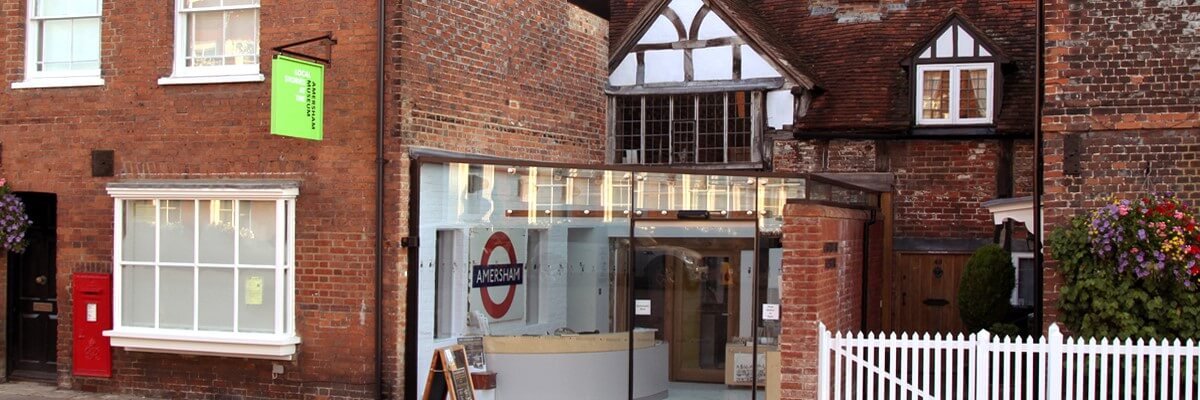This article was written by Harry Morton for the Amersham Society/Amersham Museum newsletter on a talk by Alan Wilmot and is reproduced here with permission.
Given the known wide local interest in the subject generally it was anticipated that our March lecture would be extremely popular and attract a large attendance. So it proved with extra chairs being needed and a packed Market Hall resulting. It was also thought that perhaps – a fascination with “steam” living on from younger days – the men might outnumber the ladies but not so, which was perhaps just as well because in the event the programme had somewhat limited film footage on the title subject but was supplemented by other film from the past, both nostalgic and interesting, with a broad appeal to all of the audience.
Alan Wilmot spent 30 years in documentary film making, especially those relating to railways and other aspects of travel, most of that time being spent with British Transport Films. This British Transport unit made a large number of publicity films, all covering some form of transport related subjects such as docks, waterways, London Transport, national railways and hotels. The unit was closed down in the late 1980’s but it was from its archives that Alan drew much of his material, supplemented by film footage of his own made over a period of years.
Of all of the documentary films made very few were specifically concerned with Buckinghamshire other than in a general sense but the first film to be shown was a travelogue called “London’s Country” dating from 1955 (and from the sub-titles made at Beaconsfield Studios). The theme here was how preferable it was to live in the suburbs rather than in London itself and how easy it was to commute in and out. That may well have been the case then ( with nostalgic shots of lines of passengers boarding single decker Green Line buses) and central London easily reached from all points of the outer London compass . Or so British Transport claimed! Brief cameo descriptions were used of various “desirable” locations, which did not include, alas, Amersham! This film would almost certainly have been distributed through the then ubiquitous, but now totally defunct, newsreel theatres. Apparently it won many awards and was widely shown throughout the world.
We then moved on to a short documentary film made in 1959 and titled “Bridge 114” showing the work involved in replacement of the bridge over the top of Station Road. The project was completed in 15 hours during one night and one day with the road below the bridge closed during the time. The film gave a fascinating insight into project planning and execution of the day. Notable from a 2005 standpoint was that almost every workman had a cigarette dangling from his mouth and quite clearly Health and Safety at Work regulations were much less rigorous than to-day. Men rode on top of girders while they were being hoisted by crane, helmets and goggles were not too much in evidence and I am still shuddering at the sight of men underneath the bridge’s lateral girders while they were jacking them up and then remaining there for a rest!. I suspect that if the same project were done to-day train services suspension and the road closure would last for much longer.
We then moved on to a documentary on the old Denham Film Studios “A Day at Denham”, the studios which opened in 1939 being regarded then as the finest in the UK with hundreds of workers travelling from London daily – by train of course. The site was sizeable indeed to cater for the many different types of films – many even now well remembered, especially “A Matter of Life and Death” with David Niven which still gets regular airings on television although made in 1949. In its heyday the self contained power house generated enough electricity to serve a town of 30,000 people and up to 20,000 meals per week were served to staff.
Back to rail again we were shown some rare footage from 1928 of the 6 ½ mile Brill branch of the Metropolitan Railway (known as the “Brill Tramway”) served by a single coach and engine (the latter being preserved). Then some scenes from the Chesham branch line in 1956 followed by a 1959 film of the Chesham branch line centenary with the train pulled and pushed by the diesel “Sarah Siddons” and Metro line “Loco No. 1”, also still preserved. Featured next were scenes from “Steam on the Met” days, especially of Watford and /Croxley Green en route to Amersham, and shots from the footplate on the Chesham/ Little Chalfont run. This montage ended with some shots from 1929 of engines running into Aylesbury Station.
Finally, a documentary dealing entirely with Buckinghamshire (where, 200 years ago, the people were described by one writer as “poor, ignorant and idle”), entitled “Cuckoo Land”. The narrative, read by Robert Beatty, soon made the choice of title clear, since the direction of the script, laid over the shots of almost everywhere in Bucks (again, with the exception of Amersham, for which, perhaps, much relief) was towards some of the more peculiar and eccentric characters peopling the County in days gone by .
The final comment in the film was “You don’t have to be mad to live in Buckinghamshire, but it helps”. Just so. Thankfully there was no time to debate the proposition. An interesting evening but perhaps not quite what had been expected.
See also an article on Memories of the Metropolitan Railway

